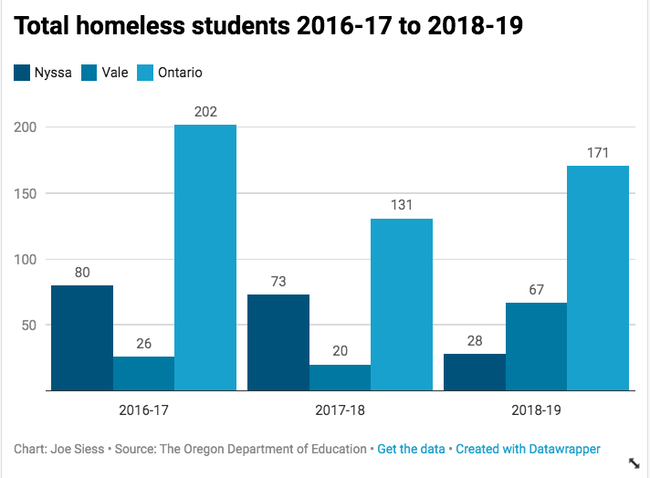
ONTARIO – As classrooms across Malheur County fill again after the holidays, the first weeks after winter break can be challenging for local homeless students and their families.
According to the most recent numbers from the Oregon Department of Education, the county as a whole logs 276 students who are considered homeless.
The three biggest school districts in the area, Nyssa, Vale and Ontario, have 28, 67, and 171 respectively. That’s a total of 266 students from kindergarten to high school designated as homeless.
They aren’t necessarily living under bridges, but are categorized as such based on their living situation.
Many are considered homeless because they are housing insecure, perhaps living in a motel or a vehicle, living with somebody other than their guardian, are doubled up with other families, or are experiencing instability at home.
Some students become homeless when their parents either leave the home, are evicted, or are unable to get into housing due to a criminal past.
Local school districts receive federal money to help these students, but districts are not allowed to use the money to help their families.
To mitigate this, some districts raise extra funds that can be used to help families with homeless students attending school.
Interviews with staff at area school districts have revealed what student homelessness looks like, what causes it, and what is being done to help.
Angie Arriola, the curriculum and instruction director for the Malheur Education Service District, tracks data concerning homeless students for all of the school districts in Malheur County.
“School districts all find ways to help out students to access education as normal as any other kid,” Arriola said. “There might not be enough money for a band instrument. Maybe this kid wants to do music or wants to play a sport, and there is a cost involved in that. School districts and the ESD help those kiddoes without making it known.”
[ KEEP YOUR LOCAL NEWS STRONG – SUBSCRIBE ]
The money is also used to buy items such as school supplies, winter coats, and backpacks.
Arriola stressed that privacy is a priority.
Districts wouldn’t allow the Enterprise to talk to students designated as homeless due to privacy restrictions.
Jeri Schaffeld, who helps homeless students in the Vale School District, said that in her district, doubled up is the most common situation for homeless students.
“Doubled up” refers to a living situation in which students and their families are living with other families instead of their own home.
Being doubled up constitutes student homelessness given the added stress associated with living with multiple people, and sharing the same amenities.
The recent numbers for the Vale district showed 47 homeless students more than last year, indicating an increased need for resources.
However, this can be explained, Schaffeld said, by the fact that many students and families designated as homeless tend to move a lot.
The same can be said for the numbers for Nyssa, which are down by 45 students from last year to 28 this year.
“I don’t think it is constant,” Schaffeld said of the state numbers. “I think people come and people go.”
“They move in with a relative or a friend and then things get stabilized someplace else and they move out,” Schaffeld said. “It just depends on their circumstances.”
Julia Muñoz is in charge of helping homeless students and their families in the Ontario school district.
The most serious situation Muñoz encounters in her district are students living with their families in vehicles.
These families sleep in their car or van and use the public restrooms at the Walmart to wash because they have nowhere else to go, Muñoz said.
Often, families end up in dire straits because they have a criminal record and are unable to qualify for housing, or they get evicted for not paying rent, Muñoz said.
“That is a big issue, and we have a lot of them,” she said.
A lot of the time, Muñoz said, families refuse help from the district because they fear that the state Department of Human Services will take custody of their children.
“They really don’t,” Muñoz said of the possibility of Human Services taking their kids. “They don’t want to, they have a hard time to place them. They try hard to keep them with the family.”
Muñoz also sees a lot of doubled up families in her district as well as unaccompanied students.
“Sometimes there are two or three families in that house,” Muñoz said. “So, we have them as homeless too, because they are using the same facilities for all of them, and that makes it hard.”
Muñoz said that her district has a hard time, especially with high school students whose parents have left the home, leaving them on their own.
This usually happens with seniors who turn 18 during the school year, and then their parents relinquish responsibility, Muñoz said.
This also happens, Muñoz said, with migrant students.
For example, if a family comes from Mexico and then the parents are deported, the student is left behind with a relative and is categorized as homeless.
Mimi Rodriguez, recruiter for the district’s migrant program said that it can also happen when the parents return to Mexico to take care of a sick relative, leaving the children behind.
“They’ll leave their kids here with a brother, cousin, sister, and those kids, even though they are with a guardian, it is not with their parents,” Rodriguez said.
Students in this situation are considered homeless and recorded as unaccompanied, given that they are not living with their parents, Rodriguez said.
Students can be identified as homeless not only when they come register for the program, but by any staff member from any school in the district, Muñoz said.
This includes teachers, principals, and kitchen staff.
“Sometimes the kids will be playing and they will hear one say to the other, ‘Oh we don’t have any light at our house, or we don’t have any running water, or I didn’t take a bath’,” Muñoz said.
“And if the teacher hears that, or any staff member, they have to fill one of these and send it to me,” Muñoz said tapping her fingers on one of the intake applications sitting on her desk.
If a student is identified as homeless at the beginning of the school year, they are treated as such for the school year, even if circumstances change, Muñoz said.
January is always the hardest, Muñoz said.
Given that the federal funding can only go towards helping students directly, Muñoz can’t use the money to help the families.
To mitigate this, the district has an annual Halloween dance fundraiser that brings in about $1,000 each year. And with this money, the district can help out families in a pinch by, for example, renting motel rooms for a night or two, buying gas, or groceries, Muñoz said.
One time, Muñoz said, she had a family sleeping in a car that requested money for gasoline so they could keep the car running at night to keep warm.
Muñoz said they often use the Halloween dance money for families who need a couple days of lodging before a social service agency steps in to help.
Some of the families who are not considered homeless can also get help. For example, Muñoz said the fund has been used to buy no slip shoes that were required for a parent who was working at a fast food restaurant.
“We don’t want them to be homeless, so we want them to have a job, to prevent it,” Muñoz said.
“It has worked pretty well,” Muñoz said of the Halloween fund. “I have used it a lot. By the end of the school year, we are almost done with the money.”
Muñoz said that more homeless shelters would help mitigate the situation with homeless students in the area.
“We have to pay for them to be in a motel, but I wish that we had a shelter where they can at least stay there temporarily for a couple of days, three days, until they can get their place,” Muñoz said. “We don’t have that. We used to, but not anymore. We have so many families that need that help and we don’t have it.”
The recently opened day shelter at the Origins Faith Community Church in Ontario has been helpful given that families can stop there for a hot meal, shower, and to wash clothes, Muñoz said.
Before the day shelter opened, she said, the district had to send families to shelters in Caldwell.
News tip? Contact reporter Joe Siess: [email protected] or 541-473-3377.
For the latest news, follow the Enterprise on Facebook and Twitter.
SUBSCRIBE TO HELP PRODUCE VITAL REPORTING — For $5 a month, you get breaking news alerts, emailed newsletters and around-the-clock access to our stories. We depend on subscribers to pay for in-depth, accurate news produced by a professional and highly trained staff. Help us grow and get better with your subscription. Sign up HERE.




